There used to be a time when people made purchases in brick-and-mortar stores. Since then, the buyer’s journey has changed significantly. The needs of consumers have also changed. Today, businesses should make the purchasing experience as smooth as possible. If you don’t want your customers to be frustrated, you need to apply an omni-channel approach to your marketing strategy.
“Omni-channel” is one of those buzzwords you probably hear a lot these days. John Bowden, Senior VP of Customer Care at Time Warner Cable, defines this term as “viewing the experience through the eyes of your customer, orchestrating the customer experience across all channels so that it is seamless, integrated and consistent.” Marketers that use an omni-channel approach align their messaging, goals, and objectives across all channels and devices.
To figure out why omni-channel marketing is critical to your success and how to effectively implement this technique, we invited Rebekah Radice to our SEMrush Chat. Rebekah is the Chief Marketing Officer of Post Planner, an award-winning content marketer, a keynote speaker, and a social media and digital marketing writer. Her blog rebekahradice.com was voted a "2016 and 2015 Top 10 Social Media Blog" by Social Media Examiner.
Let’s delve into the topic!
Q1. Why is implementing an omni-channel marketing strategy critical?
First of all, it’s important to understand that omni-channel and multichannel are two different approaches. Many companies use multiple channels for their marketing campaigns; they may have a website, a blog, and social media accounts. However, these channels are typically used separately and deprive consumers of a consistent, seamless user experience across each device, channel, and platform.
On the other hand, companies that apply an omni-channel approach try to create a unified user experience, because they understand that today’s consumers use a wide variety of channels to interact with businesses, and they often do so simultaneously. If these channels don’t work together, it’s not an omni-channel approach.
Rebekah Radice pointed out that the buyer's journey has changed; the way in which your customers arrive at your doorstep is now more complicated than ever before. “Today, customers tend to use several different channels and devices in a single purchase cycle,” explained Rebekah.
Omni-channel marketing provides users with a unified and integrated experience, regardless of the number and type of channels.
A1 Omni-channel meets the customer along their buyer's journey. No matter how or where they interact w you, there’s continuity. #semrushchat
— Rebekah Radice (@RebekahRadice) December 14, 2016
“Because your audience is not single-channel anymore. They're in multiple places — you should be, too,” tweeted ThinkSEM @ThinkSEM.
An omni-channel approach enables your customers to interact with your business in the way and at the time they prefer.
A1b: Omni channel offers the same message in a variety of modes. letting people take what they need when they need. #value #semrushchat
— Maureen Jann (@MaureenOnPoint) December 14, 2016
Consistency is another important element of omni-channel marketing. Shawn Harding @shawnbandv pointed out that having a recognizable brand is an essential part of marketing. To make your brand recognizable, you need to make sure it’s consistent across all touchpoints.
A1 the user experience is critical - you want to be found with a consistent story wherever they might go #semrushchat
— Amanda Vera (@amnda_vera) December 14, 2016
An omni-channel approach allows companies to provide their customers with relevant information and to better engage with them across multiple channels and touchpoints.
A1 #Omnichannel is all about being present on all customer touch point w/ relevant info, monitor & engage for better result #semrushchat https://t.co/PjRqmyTd48
— Varun Kumar (@varunkr842) December 14, 2016
Our chat participants agreed that today’s consumers use various channels. Your company needs to interact with your customers on their preferred channels, whether it’s social media, email, video, or a traditional phone call. “It’s pretty simple. Not all of your customers are on just one channel. You must be everywhere your customers are,” said Chris Stocker @Chris_Stocker.
A1: without #omnichannel you risk having your marketing become stagnated within a bubble & increasingly diminishing returns #semrushchat
— David Kutcher (@confluentforms) December 14, 2016
Check out a few other answers in the following recap.
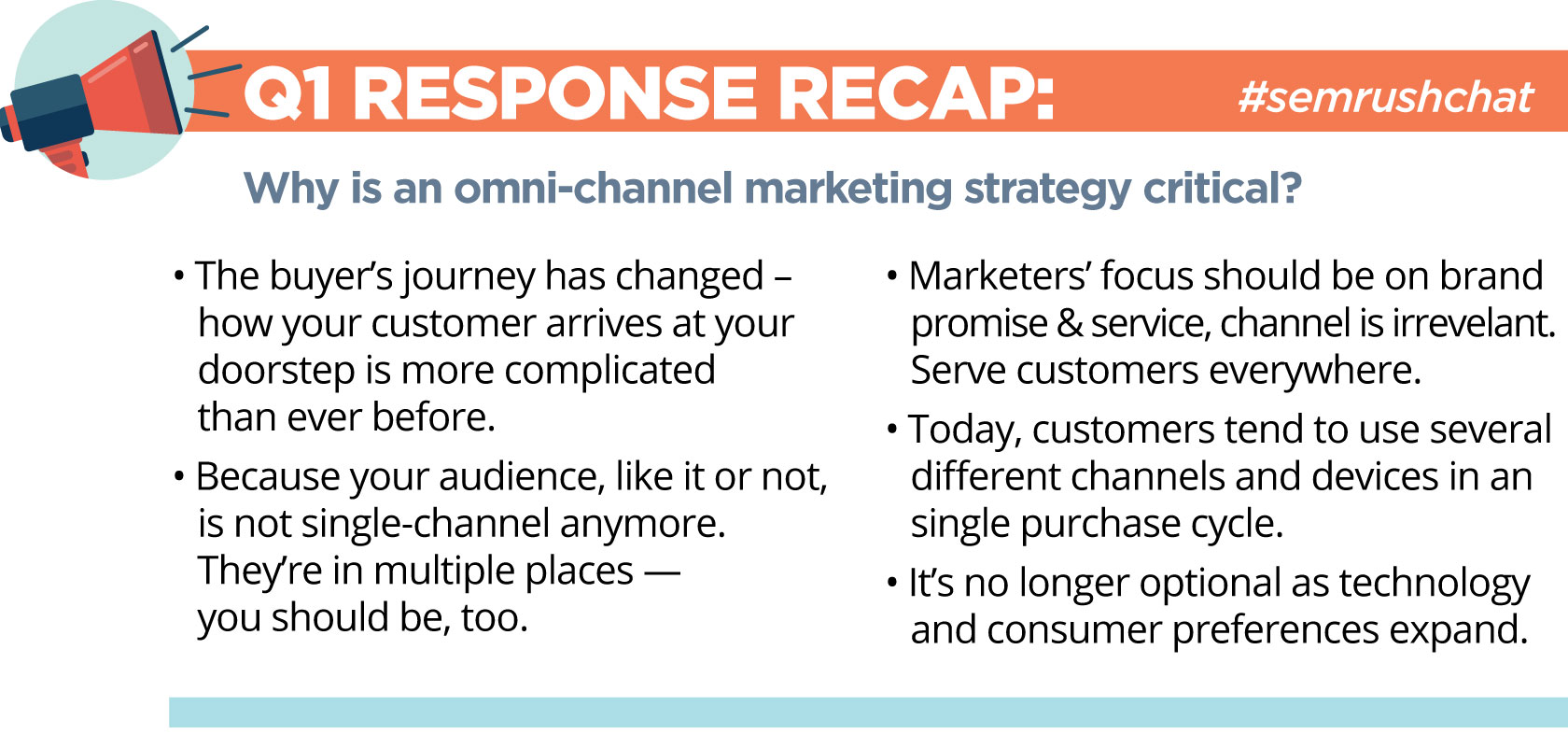
The buyer's journey has changed and it continues to do so; it’s getting more complicated with new channels and nuances that are being constantly added. Businesses need to put their customers first. Omni-channel marketing can effectively help them with this task.
Q2. How can an omni-channel marketing strategy help companies personalize customers’ experiences?
Today’s consumers spend more time researching the products and services they want to purchase. They compare prices on retailers’ websites and on their competitors’ websites, consider the opinions of other buyers, and make purchases both online and in the stores. All these changes have made an impact on customers’ experiences.
We asked our chat participants to share their opinions on how an omni-channel marketing strategy can help companies personalize their customer experience. They believe it can help you:
Better understand your customers
Rebekah Radice explained that with an omni-channel approach, you can better understand your customers. By learning their behavior on one channel, you can then use this knowledge to customize your offer on another channel. “It's a great way to learn about your audience — what channels they do and don’t prefer; what channels and formats convert,” tweeted Ryan Johnson @rsj8000.
A2 Better data means a deeper understanding of customer needs. Learn from 1 channel to improve/customize the offer on another. #semrushchat
— Rebekah Radice (@RebekahRadice) December 14, 2016
Our guest expert also believes that an omni-channel approach helps you understand and measure your customers’ habits. You need to look at their online behavior and sentiment, as well as your conversion rate, and shift your thinking. What fits one device, platform or channel might not work on the others.
A2 With omni-channel, you must shift your thinking. A one-size fits all desktop approach won't work for the mobile savvy. #semrushchat
— Rebekah Radice (@RebekahRadice) December 14, 2016
Interact with your clients via their preferred channel
To provide the best user experience, companies need to keep all their channels open for their clients. An omni-channel approach allows businesses to interact with their customers in the way they prefer and via the channel they prefer. “You can learn which is the preferred channel and focus your specific efforts. You might want to do more with an app at Christmas,” advised Andy Drinkwater @iqseo.
A2: Take the same content, deliver it 1:1 via their preferred medium for an increased chance of engagement #semrushchat pic.twitter.com/k9aUrf0o0L
— Pat Whalen (@2patwhalen) December 14, 2016
Approach your customers in a more personalized way
Marketers who understand how to leverage omni-channel marketing technology can make communications with their customers more personalized, fast, and flexible, changing their audience’s expectations. This helps brands create more engagement and build loyalty and trust with their clients.
A2: Omnichannel marketing technology gives marketers the opportunity to approach consumers in more human, personalized ways. #semrushchat
— Annaliese Henwood (@MktgInnovator) December 14, 2016
Customize your strategy for each channel
Lindsay Kavanagh believes that an omni-channel approach can help you customize your marketing strategy, which will help you better engage with your audience. The ThinkSEM team believes that this approach helps companies reach their customers where, when, and how they’d like to be reached with relevant messaging.
A2: Customize each strategy for each channel - display different content that's appealing to each channel #semrushchat
— Lindsay Kavanagh (@lindsaykavs5) December 14, 2016
Provide your customers with multiple paths to follow
By providing your audience with multiple routes to follow, you enable your clients to take the most comfortable path to you, creating a unique, satisfying customer experience. Having a well-planned omni-channel marketing strategy allows you to do this more effectively.
A2: #Semrushchat Having multi paths for customers to follow, allows them to take the most comfortable route to you. They might even skip. pic.twitter.com/UvrTLlHlhF
— Colt SebastianTaylor (@ColtSTaylor) December 14, 2016
Let’s sum up!
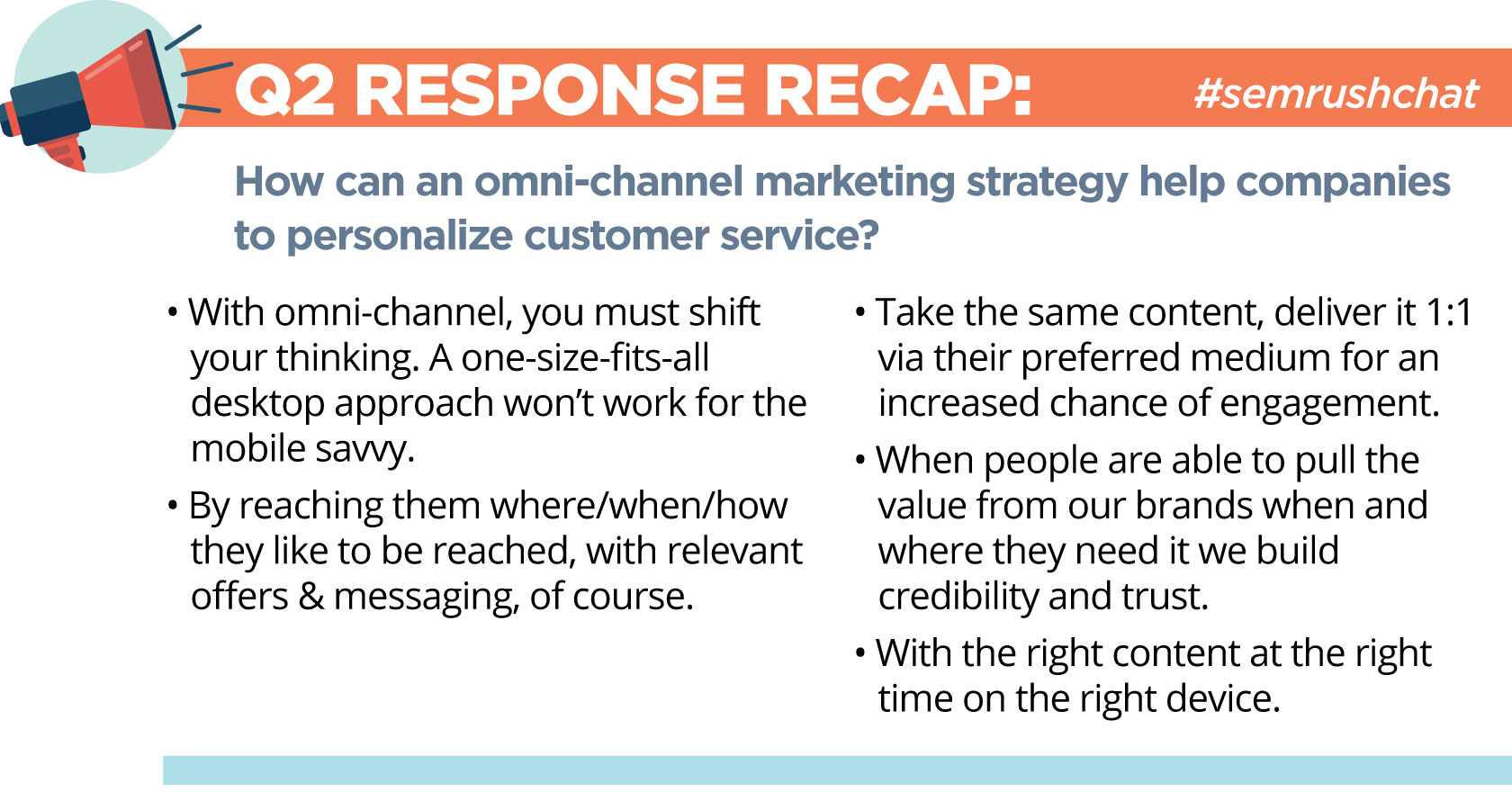
As technology continues to evolve, an increasing number of companies are able to implement omni-channel experiences into their marketing strategies and engage directly with their customers, no matter where they are and what devices they’re using.
Q3. What is the best way to implement an omni-channel marketing strategy?
Now that you know how an omni-channel marketing strategy can improve your customer experience, let’s see how you can use it in your business.
Here are five tips to effectively implement an omni-channel strategy from our chat guests.
Figure out where your audience is and how they use the channel
First of all, you need to understand which channels your customers use so you can focus your efforts on those channels. Make sure to distribute your efforts evenly among those channels. Focusing solely on social media while ignoring email communications and other channels won’t deliver positive results.
A3: Figure our where your audience is and invest time into those channels. Consistently provide valuable content. #semrushchat
— Express Writers (@ExpWriters) December 14, 2016
Chris Stocker also mentioned that it’s important to understand how your clients use certain channels.
A3 First, you have to understand how people use that channel. You can't just repost a Facebook status on Twitter #semrushchat
— Chris Stocker (@Chris_Stocker) December 14, 2016
Create buyer personas
A buyer persona is a representation of your ideal customers. Creating buyer personas helps you create content and messaging that appeals to your target audience. It also enables you to personalize your messaging for different audience groups.
A3: Don't go into it blindly. First understand your buyer persona, the problems they're having & the questions they're asking. #semrushchat pic.twitter.com/y3nXz2EbPj
— Michelle Dziuban (@dziubs) December 14, 2016
Understand who your audience is
One of the most important steps in developing an omni-channel marketing strategy is collecting data from different touchpoints you share with your customers. Rebekah Radice made a great point, saying that when you shout to many, you speak to none. That means you need to familiarize yourself with who your audience is as well as their particular struggles and needs. Rebekah advised doing research using Google search, Google Analytics, and Google Insights. Look for trends and patterns to figure out what your ideal customers are looking for.
Jeff Chinn @jchinnJRT also suggested doing research and using data: “Understand who is using which channel via what device and then customize an experience that resonates [with those users, channels and devices].”
A3: Know your audience - if 90% live on a mobile why start on a desktop or app if they can't be moved over? #semrushchat
— Andy Drinkwater (@iqseo) December 14, 2016
Be consistent
Channels that are used separately often lack consistency. You need to deliver a consistent, seamless user experience across all channels and devices that your customers use. Our special guest recommended ensuring consistency in your logo usage, font selection, and your use of color.
A3 Be consistent. Create a branded experience from your logo to colors, fonts, message and more across all channels. #semrushchat
— Rebekah Radice (@RebekahRadice) December 14, 2016
Make sure to remain consistent across all mediums. Aaron Agius shared several tips for leveraging your digital marketing campaigns offline, and vice versa. You can invite people to offline events and share QR codes online to name just a few techniques.
A3 Synchronization is needed between Digital & Offline channel. Similar brand voice & experience w/ quick decision making #semrushchat https://t.co/u2zJh4a6in
— Varun Kumar (@varunkr842) December 14, 2016
Make your message similar across all channels
You message should be similar across all channels that your audience uses. If your message is jumbled, it can confuse your customers. Today, buyers receive numerous messages from multiple channels; it’s getting more difficult to capture people’s attention. To attract an audience and make them buy from you, you need to deliver the right message at the right time through channels they use.
A3: Determine who you are as a brand. Your messaging should be similar across all channels to reduce confusion #semrushchat
— Joe Martin (@joeDmarti) December 14, 2016
Let’s sum up these key points:
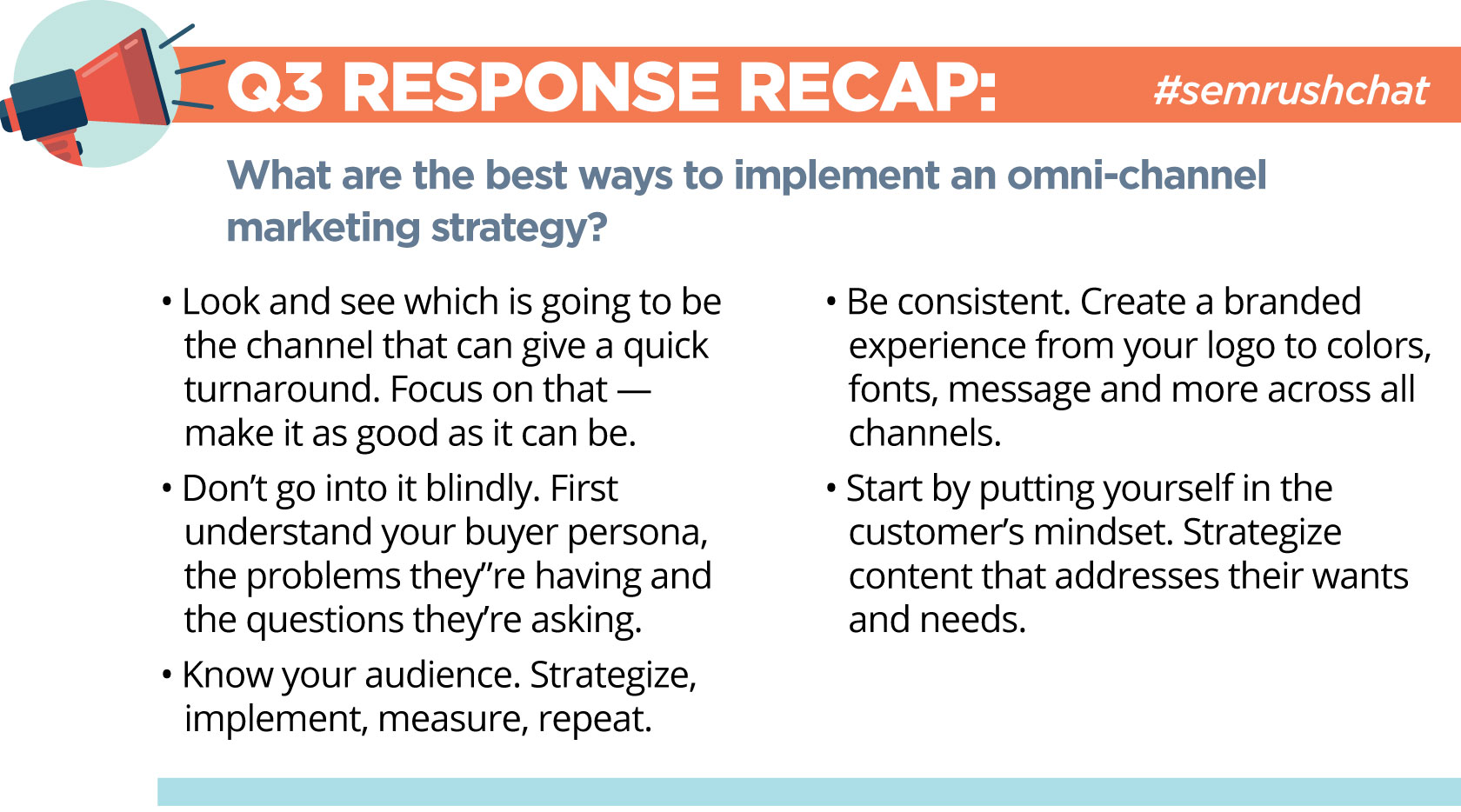
Learn more about your audience and what channels they use, create your buyer personas, be consistent, and deliver the same message across all channels.
Q4. What are the best metrics for successfully measuring ROI?
Solid metrics help you understand how effective your marketing campaigns are. Keeping track of your marketing campaign results is crucial for monitoring and measuring your return on investment.
Our chat guests shared their opinions on how to measure marketing effectiveness.
Use attribution modeling in Google Analytics
Google Analytics attribution modeling allows users to “determine how credit for sales and conversions is assigned to touchpoints in conversion paths.” Attribution modeling is a very broad topic. In a nutshell, it enables businesses to view conversion paths and analyze their marketing spend. Using attribution modeling can help you understand the buying behavior of your website visitors.
Rebekah Radice recommended using attribution modeling in order to see which touchpoints lead to behaviors like conversions and sales. She also recommended that you always track, measure, and adjust: As Chuck Palahniuk says, if you don’t know what you want, you end up with a lot you don’t.”
A4 Use attribution modeling to experiment and see which interaction points lead to behaviors like conversions and sales. #semrushchat
— Rebekah Radice (@RebekahRadice) December 14, 2016
Take into account the nature of your campaign
Jeff Chinn thinks that your choice of metrics for measuring marketing effectiveness depends on the nature of your campaign. You can measure your total website visits to see how well your campaign is driving traffic and segment your site visitors into new and returning customers. If your returning visitor traffic is low, you might want to reconsider your marketing campaign.
A4 Depends on the nature of the campaign. My favorites are audience growth, engagement, site visits and lead gen. #semrushchat
— Jeff Chinn (@jchinnJRT) December 14, 2016
Analyze how different platforms perform
The Miles Technologies team advised that you measure traffic from each platform and check how many conversions each of them has. Gathering this data will help you guide your marketing strategy.
A4: To measure your #OmniChannel marketing success, check the traffic from each platform and how many conversions each has. #semrushchat
— Miles Technologies (@milestech) December 14, 2016
Measure your click-through rate and conversion rate
Other important metrics are your click-through rate (CTR) and conversion rate. CTR captures active user responses. It’s especially useful for ad testing when you want to increase your traffic. However, it doesn’t take into account conversions or revenue goals.
Many of our chat participants mentioned conversions as the most important metric for measuring the effectiveness and profitability of your marketing efforts. Low conversion numbers can be the result of poor messaging, bad design or other problems.
A4: CTR and Conversion Rate - how effective is your marketing in getting clicks and can your site convert #semrushchat
— Lindsay Kavanagh (@lindsaykavs5) December 14, 2016
Don’t underestimate social media success metrics
Even though some marketers don’t take their social media metrics into consideration, some of these metrics can provide you with useful information. Social shares, like retweets, shares and +1’s, can indicate your audience’s reaction to your efforts. It’s a fact that people only share content that they find interesting, useful, and relevant. Besides, discovering who is sharing your content can provide you with insights into your target audience.
A4: Sales conversions are the most obvious, but social shares shouldn't be discounted for brand & community building #semrushchat
— Pat Whalen (@2patwhalen) December 14, 2016
Ignore vanity metrics
When it comes to campaign tracking, one of the common mistakes business owners make is focusing on too many vanity metrics, instead of measuring what really matters to them. Can your number of followers or page views give you an idea of how well your campaign is driving traffic? Take into consideration your goals, and don’t rely on metrics that make you feel good but don’t provide you with valuable information.
A4: Don't build hundreds of vanity metrics to report against. Yes, they look good, but do they actually mean anything? #semrushchat
— Shawn Harding (@shawnbandv) December 14, 2016
Hopefully, these tips from our chat participants will help you better measure the effectiveness of your marketing campaigns.
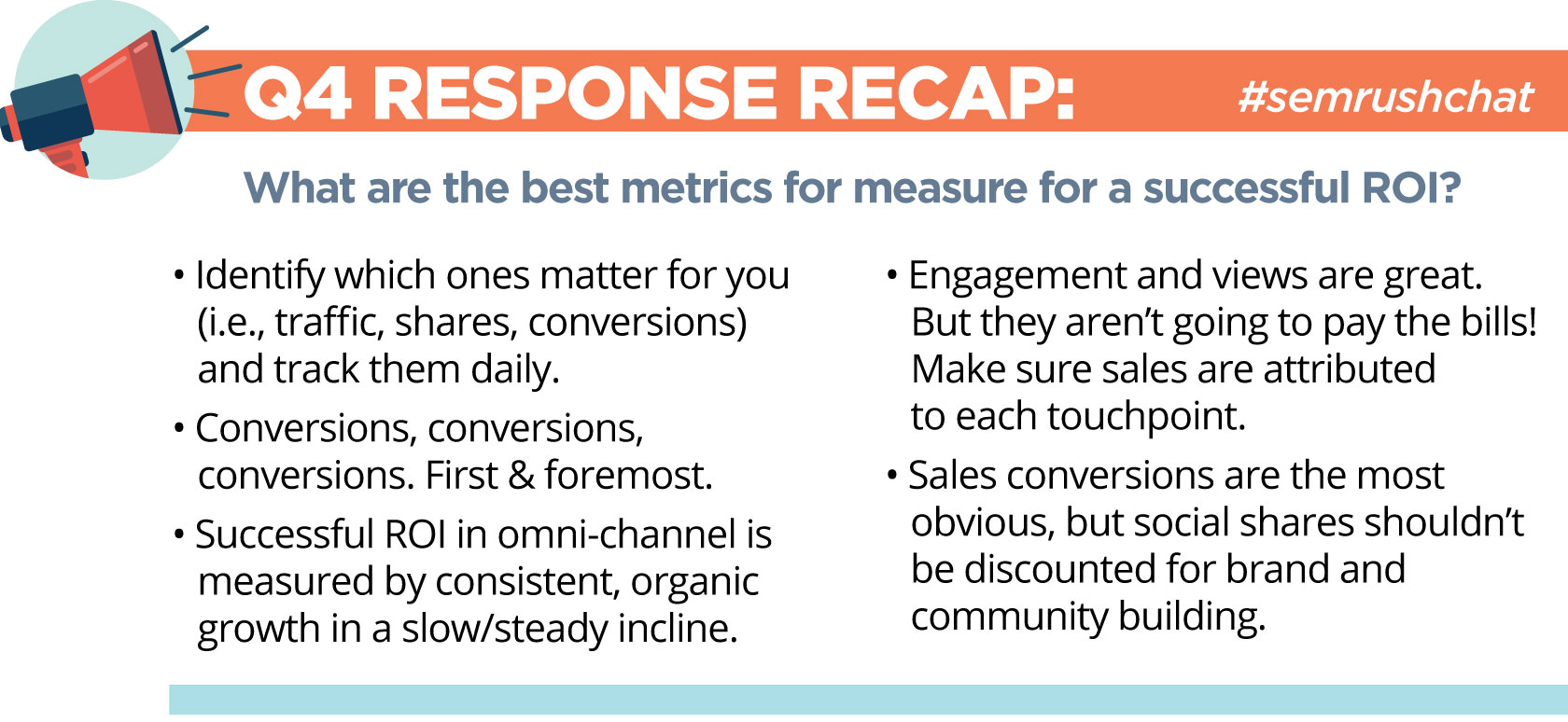
Don’t forget to always track, measure, and adjust. By focusing on the effectiveness of your campaigns, you’ll be able to drive sales and grow your company’s revenue.
Q5. Which tools do you use to track where and how customers are interacting with your brand?
At the end of our discussion, our chat participants shared several useful tools for tracking where and how your customers are interacting with your brand.
Sprout Social. Sprout Social provides a great opportunity to keep track of what your customers are saying about you and respond to them on social.
A5 @SproutSocial is a fantastic tool for monitoring what customers are saying about your brand and responding in real time. #semrushchat
— Rebekah Radice (@RebekahRadice) December 14, 2016
Google Analytics. The amount of data Google Analytics provides is immeasurable. It can be a bit overwhelming, especially for those who have just started using it. Nevertheless, this information can help you improve your website’s content, conversions, and user experience.
A5: @googleanalytics @BuzzSumo @Mention @semrush are great tools. UTM codes are also great for campaign tracking #semrushchat
— Kathleen Burns (@katbu) December 14, 2016
Mention. This web and social media monitoring tool helps you track what people are saying about your brand online. Mention assists you with building relationships, generating leads and protecting your reputation.
A5 We really like @mention and @semrush #semrushchat
— PolePositionMkg (@PolePositionMkg) December 14, 2016
BuzzSumo. By allowing users to find out what content is popular on any site or by topic, this powerful marketing tools helps you improve your content marketing and SEO campaigns. You can easily discover what content performs well in your industry and who the major influencers are.
A5 Depends on vertical and platforms. I really like #buzzsumo and other content/listening tools #semrushchat
— Chris Bell (@riskycontent) December 14, 2016
Hootsuite. Hootsuite, a platform for managing social media, helps businesses connect with their customers faster and smarter. It enables you to keep track of and manage your various social network channels, monitor what your users say about you and respond instantly.
A5 Listening tools like GA, @semrush @hootsuite @crazyegg come in handy #semrushchat
— Janil Jean (@JanilJean) December 14, 2016
Crazy Egg. Among the various visual tracking tools that Crazy Egg provides, many marketers love its Heat Map. This tools gives you a picture of where your site visitors click on your webpages and allows you to see what’s “hot” and what’s not, so you can make improvements that will increase your conversions.
A5: Google Analytics, Crazy Egg (heat mapping), and of course SEMrush #semrushchat pic.twitter.com/ZTfLtLrp1q
— Pat Whalen (@2patwhalen) December 14, 2016
Hotjar. Hotjar is a tool that reveals the online behavior of your users. By combining both analysis and feedback tools, it provides you with a deep understanding of how you can improve your website’s user experience and performance.
A5: @hotjar is an amazing tool to understand how people are navigating your site. Learn by seeing what people don't like #semrushchat
— Andy Drinkwater (@iqseo) December 14, 2016
Lucky Orange. This tool lets you quickly and easily see who is on your website and interact with them in multiple ways.
A5: @luckyorange is my secret tool. Mouse tracking/recording for your site, but can filter by source. Stupidly powerful #semrushchat
— Shawn Harding (@shawnbandv) December 14, 2016
SEMrush. We’re very pleased to know that so many of our chat participants use SEMrush to get insights into their audiences and competition, including our Brand Monitoring tool.
A5 @semrush gives insight into your audience, industry and competition. I love it for competitive analysis! #semrushchat #semrushchat
— Rebekah Radice (@RebekahRadice) December 14, 2016
A5) Analytics from Google, FB, Twitter etc. Also SEMrush for Brand mentions etc Anything that the client already pays for! #semrushchat
— David Rosam (@writingforseo) December 14, 2016
Our special guest also provided a great piece of advice – to improve your customer experience by supporting your users: “Live chat, mobile and social media support are critical tools to use.”
How do you track where your customers are interacting with your brand? What are your favorite monitoring tools?
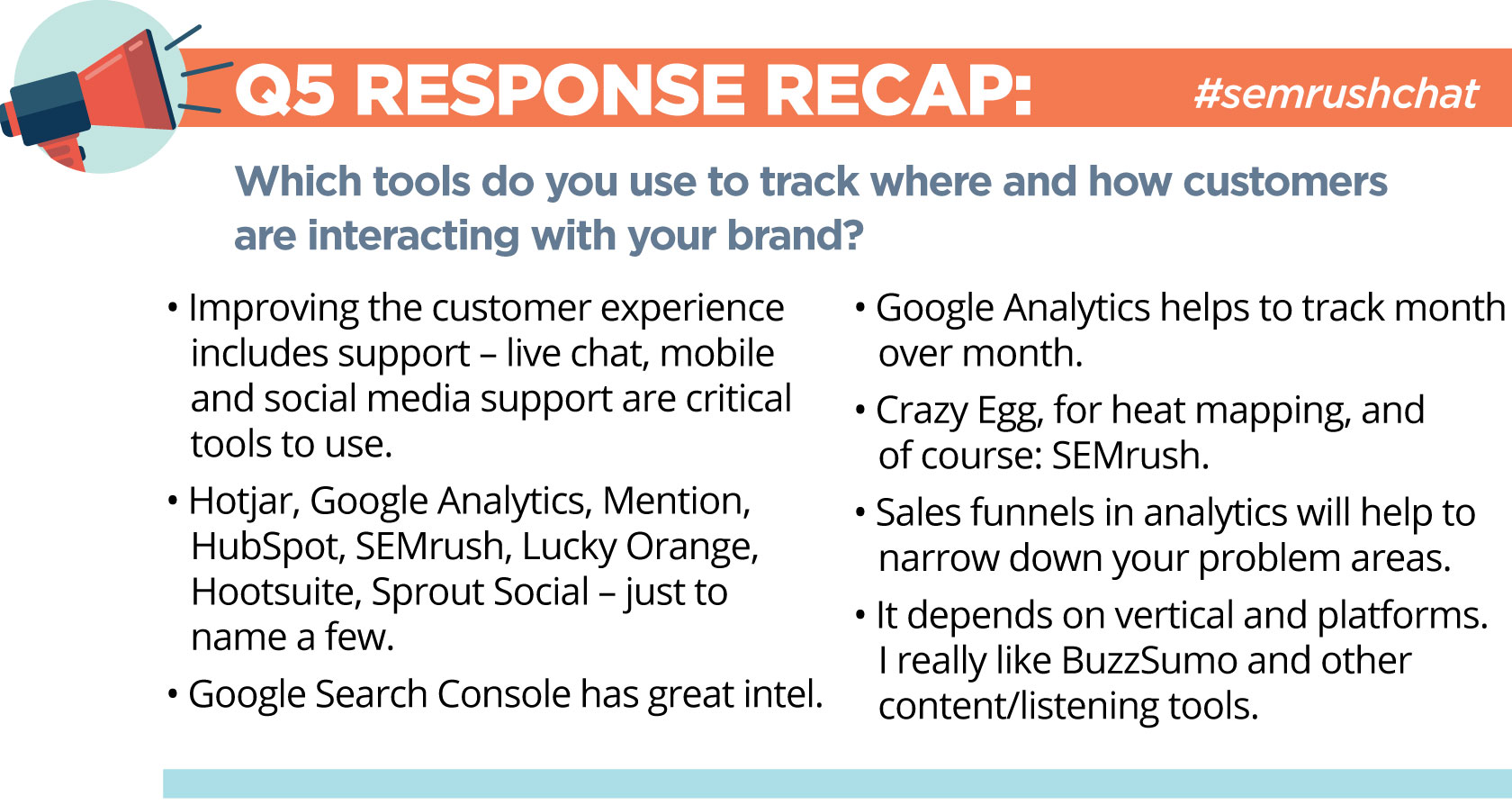
As you can see, there are so many different channels on which your customers can interact with your brand these days. You need a strategy that spans across all channels your audiences uses in order to create a seamless customer experience.
Many thanks to our special guest Rebekah Radice and our other chat participants for sharing their expertise and knowledge!
Innovative SEO services
SEO is a patience game; no secret there. We`ll work with you to develop a Search strategy focused on producing increased traffic rankings in as early as 3-months.
A proven Allinclusive. SEO services for measuring, executing, and optimizing for Search Engine success. We say what we do and do what we say.
Our company as Semrush Agency Partner has designed a search engine optimization service that is both ethical and result-driven. We use the latest tools, strategies, and trends to help you move up in the search engines for the right keywords to get noticed by the right audience.
Today, you can schedule a Discovery call with us about your company needs.
Source:





